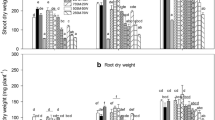Summary
Timothy hays grown with intensive soil treatments, including trace elements, (without significant differences in yields of hay per acre), were put under bioassay by weanling rabbits, only to have the high temperatures of a summer heat wave demonstrate by deaths of these test animals, regardless of soil treatments, that the protein intake (and what might accompany it) was not equal to the animal's needs. No deaths resulted in the stock rabbits in the same environment, fed on the same grain but with green grass in addition. Also, ten grams of skim-milk powder per rabbit per day prevented the death of the test rabbits as the extended heat wave permitted the demonstration. Similarly red clover hay, a replacement of the timothy, demonstrated that it also provided the protein needs to prevent deaths of the rabbits by the heat. According to the bioassays, the timothy suggests its own classification as of low potential as animal nutrition, even under extensive soil treatments growing it.
Similar content being viewed by others

Literature cited
Albrecht, Wm. A., Trace elements and agricultural production. J. Applied NutritionVIII, 352–354 (1955).
Albrecht, Wm. A., Trace elements and the production of proteins. J. Applied NutritionX, 534–543 (1957).
Albrecht, Wm. A., Pettit Gay, Lee, and Jones, G. S., Trace Elements, Allergies, and Soil Deficiencies. J. Applied NutritionXIII, 20–32 (1960).
Garner, George B.et al., Learn to live with nitrates. Missouri Agr. Expt. Sta. Bull.708 (1958).
Hampton, H. E. and Albrecht, Wm. A., Nodulation modifies nutrient intake from colloidal clay by soybeans. Soil Sci. Soc. Am. Proc.8, 234–237 (1944).
Hogan, A. G., Albrecht, Wm. A. and Norwood, Geo, Value of timothy hay as sheep feed in response to soil treatment. Missouri Agr. Expt. Sta. Bull.444, 80 (Annual Report) (1942).
Koehler, Fred and Albrecht, Wm. A., Biosynthesis of amino acids according to soil fertility. III bioassays of forage and grain fertilized with trace elements. Plant and SoilIV, 336–344 (1953).
Sheldon, V. L., Blue, Wm. G., and Albrecht, Wm. A., Biosynthesis of amino acids according to soil fertility. I Tryptophane in Forage Crops. Plant and SoilIII, 33–40 (1951).
Sheldon, V. L., Blue, Wm. G., and Albrecht, Wm. A., Biosynthesis of amino acids according to soil fertility. II Methionine content of plant and sulphur applied. Plant and SoilIII, 361–365 (1951).
Stokes, J. L., Gunnes, M., Dwyer, I. M., and Caswell, M. C., Microbiological methods for determination of amino acids. J. Biol. Chemistry,160, 35–49 (1945).
Wendel, Wilmer J., Bioassay of soil fertility under forages via selections and growth by weanling rabbits. Thesis for Masters Degree, Univ. of Missouri (1959).
What's New in Food and Drug Research. Biochemists Exploring for Metals. No. 29, January, 1962, Food and Drug Research Laboratories, Maurice Ave. at 58th. St. Maspeth 78, New York City (1962).
Author information
Authors and Affiliations
Rights and permissions
About this article
Cite this article
Albrecht, W.A., de Jonge, J. Biosynthesis of amino acids according to soil fertility. Plant Soil 18, 298–308 (1963). https://doi.org/10.1007/BF01347230
Received:
Issue Date:
DOI: https://doi.org/10.1007/BF01347230



